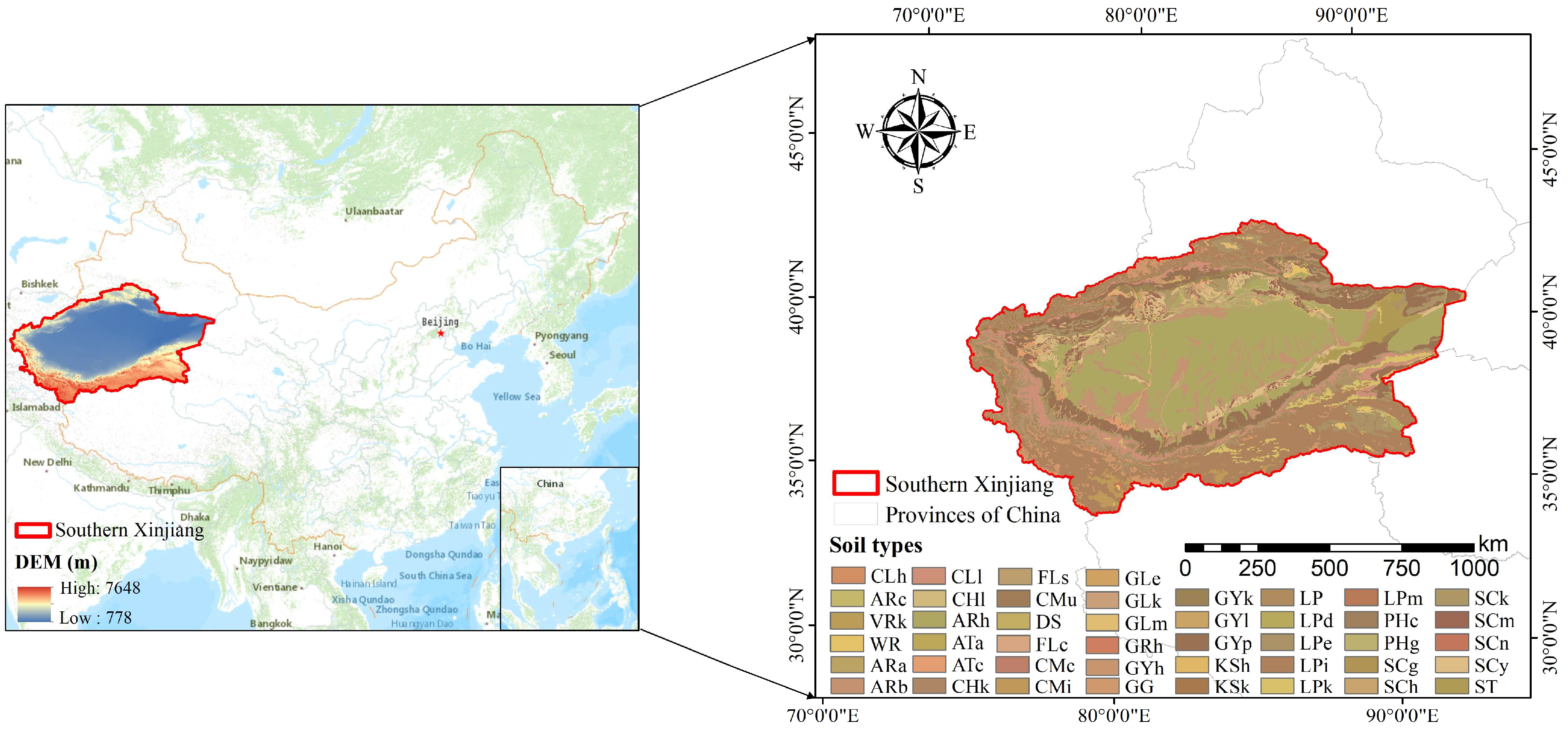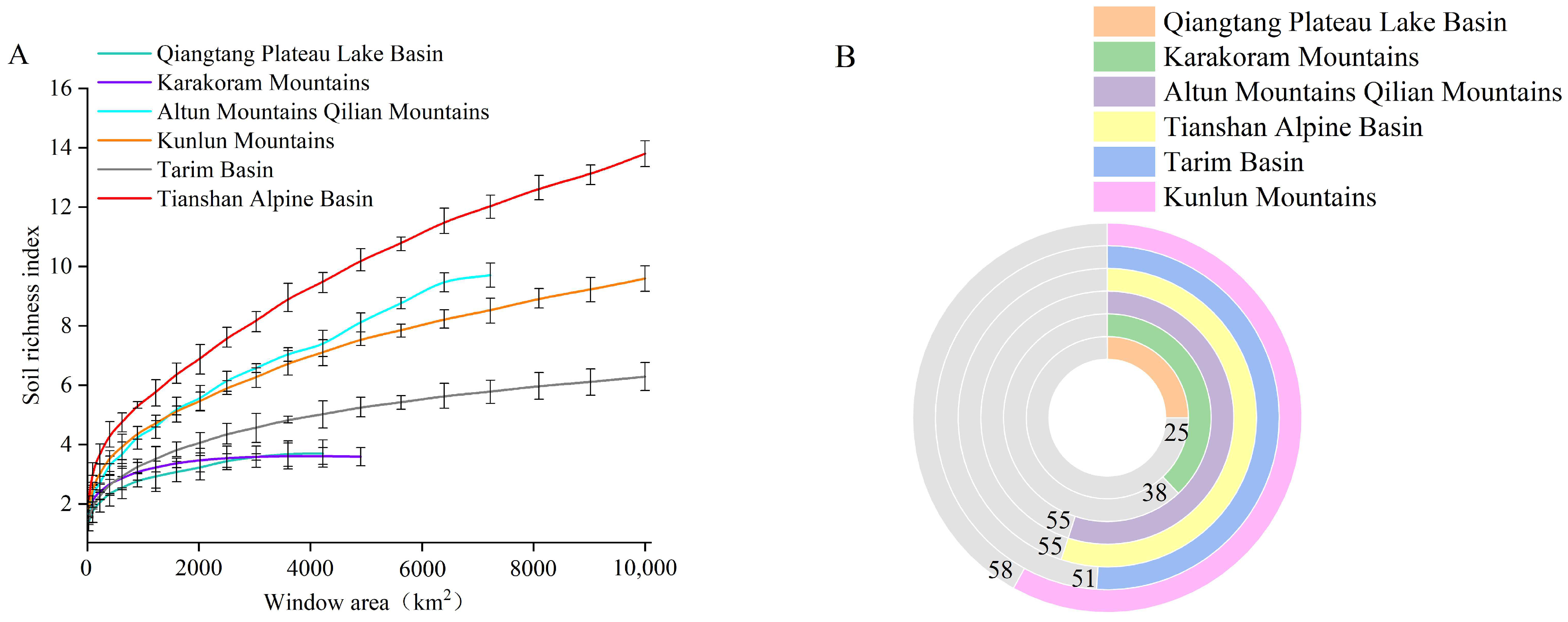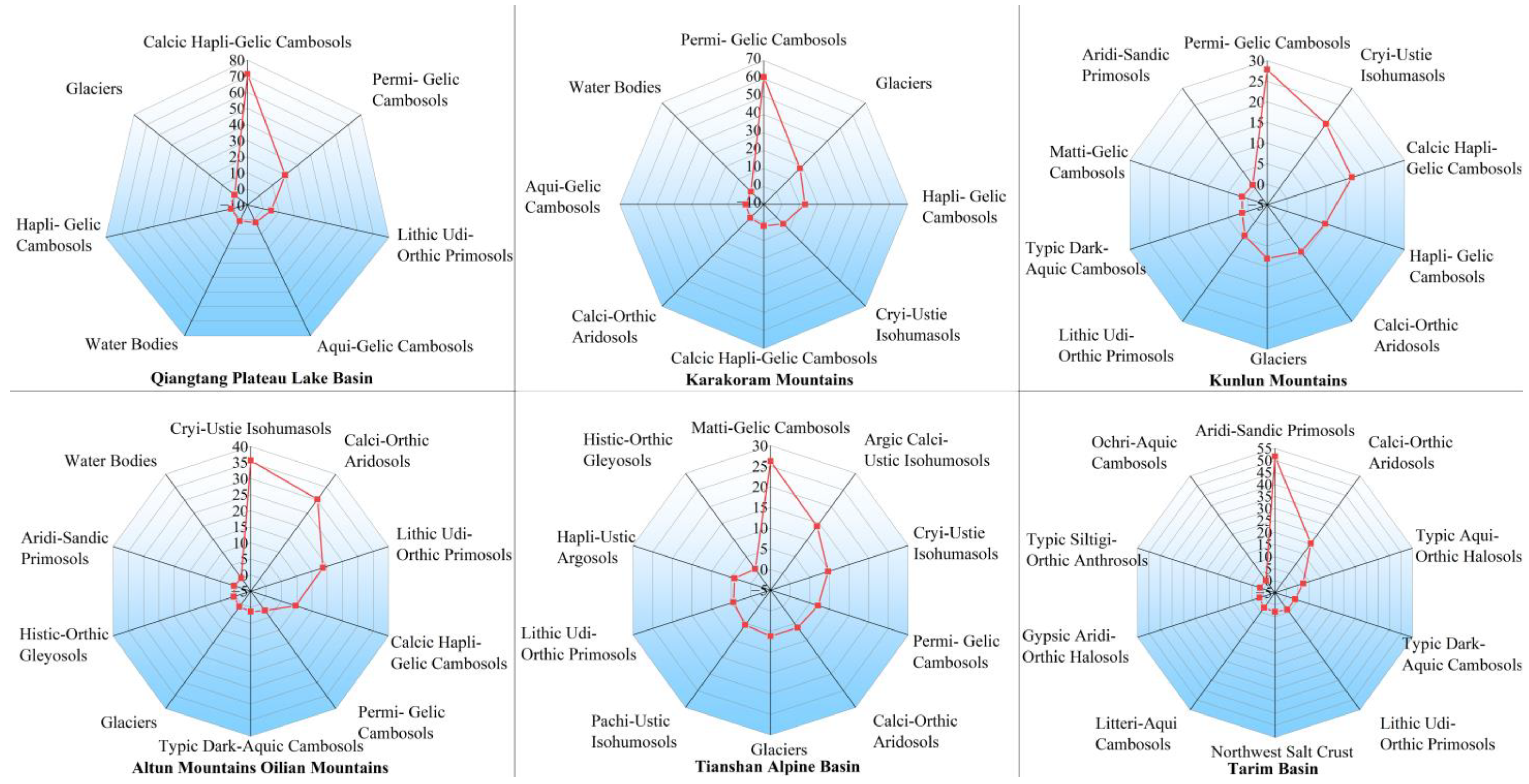Quantifying the Spatial Distribution Pattern of Soil Diversity in Southern Xinjiang and Its Influencing Factors
Abstract
:1. Introduction
2. Materials and Methods
2.1. Study Area
2.2. Data Collection and Processing
2.3. Methods of Analysis
2.3.1. Methodology for Determining the Optimal Analysis Window
2.3.2. Methodology for Calculating Soil Diversity
2.3.3. Methods for Determining Factors Influencing Soil Diversity
3. Results
3.1. Fitting of the Optimal Analysis Window
3.2. Distribution of Soil Types and Their Diversity in Southern Xinjiang
3.3. Identification of the Primary Influencing Factors of Soil Diversity
4. Discussion
4.1. Soil Diversity in Southern Xinjiang: Mountain Diversity Is Greater Than Basins, but Human Impact Is Unignorable
4.2. Factors Influencing Soil Diversity Vary across Different Regions
4.3. Limitations and Perspectives
5. Conclusions
Author Contributions
Funding
Institutional Review Board Statement
Informed Consent Statement
Data Availability Statement
Acknowledgments
Conflicts of Interest
References
- Bockheim, J.G.; Gennadiyev, A.N.; Hartemink, A.E.; Brevik, E.C. Soil-forming factors and soil taxonomy. Geoderma 2014, 226, 231–237. [Google Scholar] [CrossRef]
- Dazzi, C.; Lo Papa, G.L. Taxonomic and environmental implication of pedotechnique in large scale farming. Int. Soil Water Conserv. Res. 2016, 4, 137–141. [Google Scholar] [CrossRef]
- de Brito Neto, J.F.; Chaves, F.d.F.A.; da Silva, A.L.P.; de Mesquita, E.F.; Soares, C.S.; da Cruz, G.K.G.; Ferraz, R.L.d.S.; de Paiva, F.R.; Araújo, K.R.d.C.; Macedo, R.S.; et al. Soil Health in an Integrated Production System in a Brazilian Semiarid Region. Land 2023, 12, 2107. [Google Scholar] [CrossRef]
- Silva, L.C.; Lambers, H. Soil-plant-atmosphere interactions: Structure, function, and predictive scaling for climate change mitigation. Plant Soil 2021, 461, 5–27. [Google Scholar] [CrossRef]
- Ye, L.; Xu, Y.; Zhu, G.; Zhang, W.; Jiao, Y. Effects of Different Mulch Types on Farmland Soil Moisture in an Artificial Oasis Area. Land 2024, 13, 34. [Google Scholar] [CrossRef]
- Lal, R. Soil quality and sustainability. In Methods for Assessment of Soil Degradation; CRC Press: Boca Raton, FL, USA, 2020; pp. 17–30. [Google Scholar]
- Amundson, R.; Guo, Y.; Gong, P. Soil diversity and land use in the United States. Ecosystems 2003, 6, 470–482. [Google Scholar] [CrossRef]
- Duan, J.; Zhang, X. Correlative comparison of pedodiversity and land use diversity between case areas from the developed east and less developed central China. J. Geogr. Sci. 2012, 22, 1101–1116. [Google Scholar] [CrossRef]
- Luo, M.; Wang, T.; Li, Z.; Zhang, T.; Yang, J.; Li, N.; Li, Z. Spatial distribution characteristics of pedodiversity and its major driving factors in China based on analysis units of different sizes. Catena 2021, 207, 105701. [Google Scholar] [CrossRef]
- Delang, C.O. The consequences of soil degradation in China: A review. GeoScape 2018, 12, 92–103. [Google Scholar] [CrossRef]
- Ren, Y.; Feng, H.; Gao, T. Risk cognition, social learning, and farmers’ adoption of conservation agriculture technology. Agriculture 2023, 13, 1644. [Google Scholar] [CrossRef]
- Kang, J.; Zhang, Y.; Biswas, A. Land degradation and development processes and their response to climate change and human activity in China from 1982 to 2015. Remote Sens. 2021, 13, 3516. [Google Scholar] [CrossRef]
- Gong, Z.T.; Zhang, G.L.; Chen, Z.C. Development of soil classification in China. In Soil Classification; CRC Press: Boca Raton, FL, USA, 2002; pp. 101–126. [Google Scholar]
- Amundson, R.; Berhe, A.A.; Hopmans, J.W.; Olson, C.; Sztein, A.E.; Sparks, D.L. Soil and human security in the 21st century. Science 2015, 348, 1261071. [Google Scholar] [CrossRef] [PubMed]
- Chen, Y.; Huang, X.; Lang, X.; Tang, R.; Zhang, R.; Li, S.; Su, J. Effects of plant diversity, soil microbial diversity, and network complexity on ecosystem multifunctionality in a tropical rainforest. Front. Plant Sci. 2023, 14, 40–51. [Google Scholar] [CrossRef] [PubMed]
- Costantini, E.A.; Mocali, S. Soil health, soil genetic horizons and biodiversity#. J. Plant Nutr. Soil Sci. 2022, 185, 24–34. [Google Scholar]
- Ibáñez, J.J.; Feoli, E. Global relationships of pedodiversity and biodiversity. Vadose Zone J. 2013, 12, 0186. [Google Scholar] [CrossRef]
- Ibañez, J.J.; De-Alba, S.; Lobo, A.; Zucarello, V. Pedodiversity and global soil patterns at coarse scales (with discussion). Geoderma 1998, 83, 171–192. [Google Scholar] [CrossRef]
- Phillips, J.D.; Marion, D.A. Biomechanical effects, lithological variations, and local pedodiversity in some forest soils of Arkansas. Geoderma 2005, 124, 73–89. [Google Scholar] [CrossRef]
- Phillips, J.D.; Marion, D.A. Soil geomorphic classification, soil taxonomy, and effects on soil richness assessments. Geoderma 2007, 141, 89–97. [Google Scholar] [CrossRef]
- Guo, Y.; Amundson, R.; Gong, P.; Ahrens, R. Taxonomic structure, distribution, and abundance of the soils in the USA. Soil Sci. Soc. Am. J. 2003, 67, 1507–1516. [Google Scholar] [CrossRef]
- Guo, Y.; Gong, P.; Amundson, R. Pedodiversity in the United States of America. Geoderma 2003, 117, 99–115. [Google Scholar] [CrossRef]
- Bennett, J.M.; McBratney, A.; Field, D.; Kidd, D.; Stockmann, U.; Liddicoat, C.; Grover, S. Soil security for Australia. Sustainability 2019, 11, 3416. [Google Scholar] [CrossRef]
- Techen, A.K.; Helming, K. Pressures on soil functions from soil management in Germany. A foresight review. Agron. Sustain. Dev. 2017, 37, 64. [Google Scholar] [CrossRef]
- Papa, G.L.; Palermo, V.; Dazzi, C. Is land-use change a cause of loss of pedodiversity? The case of the Mazzarrone study area, Sicily. Geomorphology 2011, 135, 332–342. [Google Scholar] [CrossRef]
- Bhattacharyya, T. Soil diversity in India. J. Indian Soc. Soil Sci. 2016, 64, S41–S52. [Google Scholar]
- Krasilnikov, P.V.; Gerasimova, M.I.; Golovanov, D.L.; Konyushkova, M.V.; Sidorova, V.A.; Sorokin, A.S. Pedodiversity and its significance in the context of modern soil geography. Eurasian Soil Sci. 2018, 51, 1–13. [Google Scholar] [CrossRef]
- Smirnova, M.; Bocharnikov, M. Ecosystem, Vegetation and Soil Diversity of the Mountain Forest-Steppe of West Altai (a Case Study of The Tigirek State Natural Reserve). Proc. IOP Conf. Ser. Earth Environ. Sci. 2021, 908, 012028. [Google Scholar] [CrossRef]
- Fu, T.; Han, L.; Gao, H.; Liang, H.; Liu, J. Geostatistical analysis of pedodiversity in Taihang mountain region in north China. Geoderma 2018, 328, 91–99. [Google Scholar] [CrossRef]
- Samec, P.; Volánek, J.; Kučera, M.; Cudlín, P. Effect of soil diversity on forest plant species abundance: A case study from central-European highlands. Forests 2021, 12, 534. [Google Scholar] [CrossRef]
- Zhou, Y.; Li, Y.; Li, W.; Li, F.; Xin, Q. Ecological responses to climate change and human activities in the arid and semi-arid regions of Xinjiang in China. Remote Sens. 2022, 14, 3911. [Google Scholar] [CrossRef]
- Yu, X.; Lei, J.; Gao, X. An over review of desertification in Xinjiang, northwest China. J. Arid Land 2022, 14, 1181–1195. [Google Scholar] [CrossRef]
- Wilson, M.J. The importance of parent material in soil classification: A review in a historical context. Catena 2019, 182, 104131. [Google Scholar] [CrossRef]
- Patil, A.; Lamnganbi, M. Impact of climate change on soil health: A review. Int. J. Chem. Stud 2018, 6, 2399–2404. [Google Scholar]
- Rothacker, L.; Dosseto, A.; Francke, A.; Chivas, A.R.; Vigier, N. Impact of climate change and human activity on soil landscapes over the past 12,300 years. Sci. Rep. 2018, 8, 247. [Google Scholar] [CrossRef] [PubMed]
- Wieder, W.L.; Shoop, S.A. State of the knowledge of vegetation impact on soil strength and trafficability. J. Terramech. 2018, 78, 1–14. [Google Scholar] [CrossRef]
- Zhu, M.; Feng, Q.; Qin, Y.; Cao, J.; Zhang, M. The role of topography in shaping the spatial patterns of soil organic carbon. Catena 2019, 176, 296–305. [Google Scholar] [CrossRef]
- Wang, N.; Cheng, W.; Wang, B.; Liu, Q.; Zhou, C. Geomorphological regionalization theory system and division methodology of China. J. Geogr. Sci. 2020, 30, 212–223. [Google Scholar] [CrossRef]
- Li, B.; Pan, B.; Cheng, W.; Han, J.; Qi, D.; Zhu, C. Research on geomorphological regionalization of China. Acta Geogr. Sin. 2013, 68, 291–306. [Google Scholar]
- Guan, X.; Shen, H.; Wang, Y.; Chu, D.; Li, X.; Yue, L.; Liu, X.; Zhang, L. Fusing MODIS and AVHRR products to generate a global 1-km continuous NDVI time series covering four decades. Earth Syst. Sci. Data Discuss. 2021, 12, 1–32. [Google Scholar]
- Ibáñez, J.J.; Caniego, J.; San José, F.; Carrera, C. Pedodiversity-area relationships for islands. Ecol. Modell. 2005, 182, 257–269. [Google Scholar] [CrossRef]
- Zhu, L.; Meng, J.; Zhu, L. Applying Geodetector to disentangle the contributions of natural and anthropogenic factors to NDVI variations in the middle reaches of the Heihe river basin. Ecol. Indic. 2020, 117, 106545. [Google Scholar] [CrossRef]
- Jansson, J.K.; Hofmockel, K.S. Soil microbiomes and climate change. Nat. Rev. Microbiol. 2020, 18, 35–46. [Google Scholar] [CrossRef]
- Gracheva, R. Formation of soil diversity in the mountainous tropics and subtropics: Rocks, time, and erosion. Geomorphology 2011, 135, 224–231. [Google Scholar] [CrossRef]
- Ibáñez, J.; Caniego, J.; Garcıa-Alvarez, A. Nested subset analysis and taxa-range size distributions of pedological assemblages: Implications for biodiversity studies. Ecol. Modell. 2005, 182, 239–256. [Google Scholar] [CrossRef]
- Yakovenko, V.; Kunakh, O.; Tutova, H.; Zhukov, O. Diversity of soils in the Dnipro river valley (based on the example of the Dnipro-Orilsky nature reserve). Folia Oecol. 2023, 50, 119–133. [Google Scholar] [CrossRef]
- Li, Z.; Liu, H.; Yang, H.; Wang, T. Effects of deep vertical rotary tillage management methods on soil quality in saline cotton fields in southern Xinjiang. Agriculture 2023, 13, 1864. [Google Scholar] [CrossRef]
- Ma, T.; Deng, X.; Chen, L.; Xiang, W. The soil properties and their effects on plant diversity in different degrees of rocky desertification. Sci. Total Environ. 2020, 736, 139667. [Google Scholar] [CrossRef] [PubMed]
- Jin, C.; Wang, B.; Cheng, T.F.; Dai, L.; Wang, T. How much we know about precipitation climatology over Tianshan Mountains––the Central Asian water tower. NPJ Clim. Atmos. Sci. 2019, 7, 21. [Google Scholar] [CrossRef]
- Yang, T.; Siddique, K.H.M.; Liu, K. Cropping systems in agriculture and their impact on soil health—A review. Glob. Ecol. Conserv. 2020, 23, e01118. [Google Scholar] [CrossRef]
- Minasny, B.; McBratney, A.B.; Hartemink, A.E. Global pedodiversity, taxonomic distance, and the world reference base. Geoderma 2010, 155, 132–139. [Google Scholar] [CrossRef]
- Fu, T.; Liu, J.; Jiang, G.; Gao, H.; Qi, F.; Wang, F. Influences of pedodiversity on ecosystem services in a mountainous area. Catena 2022, 217, 106505. [Google Scholar] [CrossRef]
- Fu, T.; Han, L.; Gao, H.; Liang, H.; Li, X.; Liu, J. Pedodiversity and its controlling factors in mountain regions—A case study of Taihang mountain, China. Geoderma 2018, 310, 230–237. [Google Scholar] [CrossRef]
- Mikhailova, E.A.; Zurqani, H.A.; Post, C.J.; Schlautman, M.A.; Post, G.C. Soil diversity (pedodiversity) and ecosystem services. Land 2021, 10, 288. [Google Scholar] [CrossRef]
- Gerasimova, M.I.; Golovleva, I.A.; Konyushkova, M.V.; Sorokin, A.S.; Krasilnikov, P.V. Assessment of soil diversity using soil maps with different scales in eastern Fennoscandia, Russia. Geoderma Reg. 2020, 21, e00274. [Google Scholar] [CrossRef]







| Geomorphologic Region | S = aln(bA + 1) | S = aAb | ||||
|---|---|---|---|---|---|---|
| a | b | R2 | a | b | R2 | |
| Qiangtang Plateau Lake Basin | 0.492 ± 0.026 | 0.374 ± 0.119 | 0.971 ± 0.016 | 0.718 ± 0.022 | 0.199 ± 0.004 | 0.996 ± 0.002 |
| Karakoram Mountains | 0.396 ± 0.014 | 2.543 ± 0.516 | 0.986 ± 0.007 | 1.163 ± 0.066 | 0.140 ± 0.007 | 0.971 ± 0.011 |
| Kunlun Mountains | 1.790 ± 0.146 | 0.014 ± 0.005 | 0.942 ± 0.317 | 0.532 ± 0.032 | 0.312 ± 0.007 | 0.994 ± 0.034 |
| Altun Mountains Qilian Mountains | 2.305 ± 0.259 | 0.007 ± 0.002 | 0.934 ± 0.417 | 0.323 ± 0.037 | 0.380 ± 0.014 | 0.987 ± 0.081 |
| Tianshan Alpine Basin | 2.152 ± 0.147 | 0.019 ± 0.005 | 0.957 ± 0.375 | 0.797 ± 0.037 | 0.294 ± 0.004 | 0.997 ± 0.020 |
| Tarim Basin | 1.021 ± 0.064 | 0.034 ± 0.010 | 0.957 ± 0.093 | 0.548 ± 0.016 | 0.265 ± 0.03 | 0.998 ± 0.004 |
| Geomorphologic Region | Area Proportion (%) | Richness Index | Diversity Index | Evenness Index |
|---|---|---|---|---|
| Qiangtang Plateau Lake Basin | 2.84 | 7 | 0.528 ± 0.119 | 0.575 ± 0.123 |
| Karakoram Mountains | 3.34 | 8 | 0.748 ± 0.083 | 0.633 ± 0.086 |
| Kunlun Mountains | 18.80 | 19 | 1.247 ± 0.103 | 0.670 ± 0.122 |
| Altun Mountains Qilian Mountains | 3.37 | 12 | 1.383 ± 0.091 | 0.743 ± 0.082 |
| Tianshan Alpine Basin | 11.31 | 18 | 1.728 ± 0.165 | 0.786 ± 0.078 |
| Tarim Basin | 60.35 | 23 | 0.677 ± 0.011 | 0.395 ± 0.096 |
Disclaimer/Publisher’s Note: The statements, opinions and data contained in all publications are solely those of the individual author(s) and contributor(s) and not of MDPI and/or the editor(s). MDPI and/or the editor(s) disclaim responsibility for any injury to people or property resulting from any ideas, methods, instructions or products referred to in the content. |
© 2024 by the authors. Licensee MDPI, Basel, Switzerland. This article is an open access article distributed under the terms and conditions of the Creative Commons Attribution (CC BY) license (https://creativecommons.org/licenses/by/4.0/).
Share and Cite
Luo, J.; Fan, Y.; Wu, H.; Cheng, J.; Yang, R.; Zheng, K. Quantifying the Spatial Distribution Pattern of Soil Diversity in Southern Xinjiang and Its Influencing Factors. Sustainability 2024, 16, 2561. https://doi.org/10.3390/su16062561
Luo J, Fan Y, Wu H, Cheng J, Yang R, Zheng K. Quantifying the Spatial Distribution Pattern of Soil Diversity in Southern Xinjiang and Its Influencing Factors. Sustainability. 2024; 16(6):2561. https://doi.org/10.3390/su16062561
Chicago/Turabian StyleLuo, Junteng, Yanmin Fan, Hongqi Wu, Junhui Cheng, Rui Yang, and Kai Zheng. 2024. "Quantifying the Spatial Distribution Pattern of Soil Diversity in Southern Xinjiang and Its Influencing Factors" Sustainability 16, no. 6: 2561. https://doi.org/10.3390/su16062561






